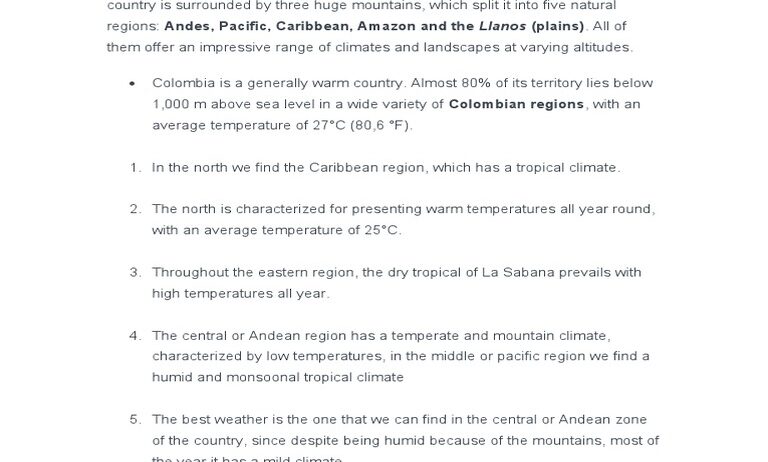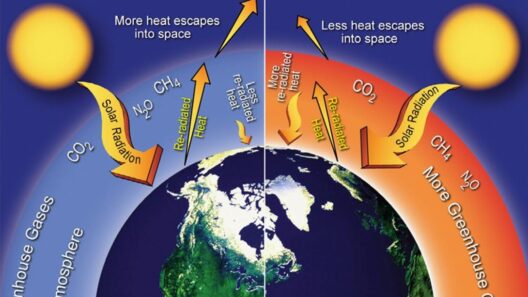Colombia, a country nestled in the northwestern corner of South America, boasts an impressive array of climates that range from verdant rainforests to arid highlands. Characterized by its rich biodiversity and varying elevations, Colombia presents a unique tapestry of weather patterns throughout the year. Understanding the country’s climate is not merely an academic endeavor; it compels one to appreciate the interconnectedness of ecosystems and the impact of human activities on our fragile planet. This exploration into Colombia’s climatic zones promises to shift perspectives on how we define weather and its implications on everyday life.
Venturing into the Lowlands: Tropical Rainforests
Colombia’s lowland regions, particularly in the Amazon basin and the Pacific coast, are dominated by tropical rainforest climates. Here, humidity reigns supreme, and the average temperature hovers around a sultry 26°C to 28°C (79°F to 82°F) throughout the year. The precipitation in these areas can be staggering, with some regions receiving over 3,000 millimeters (118 inches) annually. Rainfall is frequent and often torrential, contributing to the lush vegetation that characterizes this biome.
One might wonder, how does such an environment foster an exceptional variability in flora and fauna? In Colombia’s tropical rainforests, biodiversity flourishes due in part to the warm, moist conditions that create ideal habitats for countless species. The intricate relationships among plants, animals, and microorganisms work in a delicate balance, showcasing nature’s resilience. The vibrant ecosystems support not only towering trees and colorful orchids but also creatures like jaguars, sloths, and myriad bird species, adding to the area’s ethereal beauty.
Yet, these rainforests confront challenges. Deforestation, driven by agricultural expansion and illegal logging, poses significant threats to biodiversity. Highlighting these concerns raises awareness and spurs action towards conservation. Promoting sustainable practices is crucial to preserving these vital ecosystems that serve as the lungs of the planet.
The Highland’s Enchantment: Mountain Climates
As one ascends into the Andean mountains, a dramatic transformation occurs. The climate shifts from the sultry lowlands to a cooler, temperate atmosphere. Different altitudinal zones emerge, each with its unique climatic conditions. Generally, as elevation increases, temperatures decrease. In the highlands, one can find a variety of microclimates, ranging from chilly, montane cloud forests to arid páramo ecosystems above the tree line.
In Bogotá, Colombia’s capital located at an altitude of approximately 2,600 meters (8,530 feet), the climate is classified as a cool subtropical highland climate. Temperatures are considerably milder, averaging between 14°C to 18°C (57°F to 64°F). The city experiences distinct wet and dry seasons, with heavier rains typically falling between April and November. Such variability contributes to a rich agricultural tapestry, where the high-altitude crops like potatoes and quinoa thrive, delivering food security to local communities.
High in the mountains, one encounters the fascinating páramo ecosystems, unique to the Andean regions. This delicate biome is characterized by its unique flora, including the frailejón, a plant with a rosette of leaves that captures moisture from the mist. The páramo serves as a crucial water source, capturing and storing rainwater, thereby replenishing the rivers and lakes that sustain millions downstream. However, with climate change, these ecosystems are under threat, as rising temperatures jeopardize their delicate balance. Protecting these areas is integral to maintaining the hydrological cycle and enhancing resilience in the face of climate variability.
Embracing Diversity: The Interplay of Climates
Colombia’s climate is not merely about temperature and precipitation; it’s a celebration of diversity in ecosystems and cultures. Each climatic zone offers its breed of indigenous communities, agricultural practices, and lifestyles finely tuned to their environments. Coastal regions along the Caribbean and Pacific exhibit yet another flavor of climate, with tropical savanna and maritime influences shaping unique weather patterns. The Caribbean coast benefits from a warm, humid, and tropical climate, characterized by dry and rainy seasons, which shape everything from cuisine to festivals.
This tapestry of climatic experiences fosters a rich cultural heritage, seen in traditional festivals celebrating the rain, food that celebrates the local bounty, and lifestyle choices shaped by their intricate relationship with nature. The interactions between the various climates are pivotal to understanding the overarching environmental narrative. As Colombia grapples with the realities of climate change, understanding these climatic variations becomes all the more critical.
In conclusion, the climate of Colombia is as complex and diverse as its people and landscapes. From the rain-soaked forests of the Amazon to the sun-drenched beaches of the Caribbean coast and the frosty peaks of the Andes, each climatic zone presents not only unique challenges but also unparalleled opportunities. The story of Colombia’s climate encourages an appreciation of the urgent need for conservation efforts and sustainable practices. In this context – the preservation of biodiversity and the promotion of social equity – offers a renewed perspective on how we engage with our planet and its myriad cultures.





